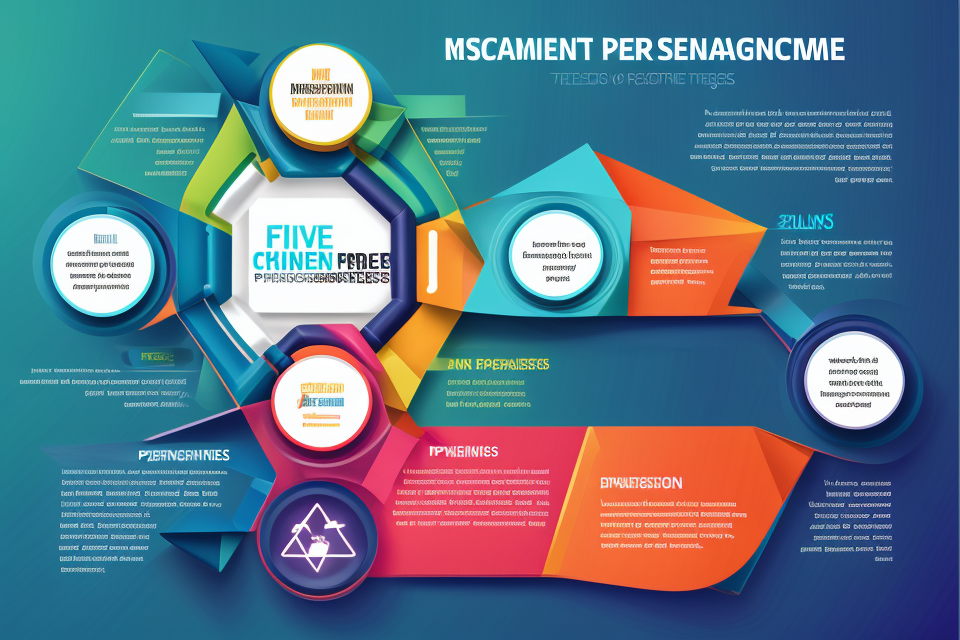Supply chain management is the process of managing the flow of goods and services from the supplier to the customer. It involves a range of activities such as procurement, production, storage, transportation, and distribution. In this article, we will explore the five key processes of supply chain management that are essential for ensuring smooth and efficient operations. From sourcing raw materials to delivering finished products to customers, these processes play a critical role in determining the success of any business. So, let’s dive in and discover the five crucial steps that make up the supply chain management process.
What is Supply Chain Management?
Definition and Importance
Definition
Supply chain management (SCM) is the management of the flow of goods and services, including raw materials, intermediate goods, and finished products, from the point of origin to the point of consumption. It involves coordinating and integrating all activities related to the production, storage, transportation, and distribution of these goods and services.
Importance
Supply chain management is crucial for businesses as it helps them to achieve their goals by ensuring that the right products are delivered to the right customers at the right time, in the right quantities, and at the right cost. A well-managed supply chain can provide several benefits, including:
- Improved customer service: By ensuring that products are delivered on time and in full, businesses can improve customer satisfaction and loyalty.
- Reduced costs: By optimizing inventory levels, reducing transportation and storage costs, and minimizing waste, businesses can reduce their overall costs.
- Increased efficiency: By streamlining processes and reducing delays, businesses can improve the speed and efficiency of their operations.
- Enhanced competitiveness: By providing better customer service and reducing costs, businesses can gain a competitive advantage over their rivals.
In today’s global economy, supply chain management has become even more critical as businesses operate in complex and dynamic environments. A well-designed and efficiently managed supply chain can provide businesses with a significant advantage in the marketplace.
Key Components of Supply Chain Management
Supply chain management (SCM) is a critical function in businesses that involves coordinating and integrating all activities related to the production and distribution of goods and services. It encompasses various key components that work together to ensure the efficient and effective flow of materials, information, and finances throughout the supply chain. The following are the key components of supply chain management:
- Demand forecasting: This is the process of predicting future demand for products or services based on historical data, market trends, and other relevant factors. Accurate demand forecasting enables businesses to plan their production and inventory levels, ensuring that they meet customer needs while minimizing waste and costs.
- Supplier selection and management: This involves identifying and selecting suppliers who can provide the necessary raw materials, components, or finished goods at the required quality, quantity, and price. Supplier management includes negotiating contracts, monitoring performance, and resolving any issues that may arise during the supply process.
- Inventory management: Inventory management involves monitoring and controlling the levels of raw materials, work-in-progress, and finished goods in the supply chain. The goal is to ensure that inventory levels are sufficient to meet customer demand while minimizing storage costs and reducing the risk of stockouts or excess inventory.
- Production planning and scheduling: This involves coordinating the production process to ensure that products are manufactured efficiently and effectively. Production planning and scheduling involve determining the quantity and sequence of orders, allocating resources, and ensuring that production capacity is utilized optimally.
- Distribution and logistics: This component involves managing the transportation, warehousing, and delivery of goods to customers. Effective distribution and logistics strategies ensure that products are delivered on time, in good condition, and at the lowest possible cost.
- Information technology and systems integration: Information technology plays a critical role in supply chain management by providing the necessary tools and systems to manage and track the flow of materials, information, and finances throughout the supply chain. Systems integration involves linking different systems and processes across the supply chain to ensure seamless communication and collaboration between different stakeholders.
In summary, the key components of supply chain management are demand forecasting, supplier selection and management, inventory management, production planning and scheduling, distribution and logistics, and information technology and systems integration. These components work together to create a seamless and efficient supply chain that meets customer needs while minimizing costs and waste.
Process 1: Plan
The first key process in supply chain management is planning. This process involves developing a strategy for managing the flow of goods and services from suppliers to customers. The plan process is critical in ensuring that the supply chain is efficient, effective, and aligned with the overall business strategy.
The following are the key activities involved in the plan process:
- Demand forecasting: This involves predicting future demand for products or services based on historical data, market trends, and other factors. Accurate demand forecasting is essential for ensuring that the supply chain can meet customer demand.
- Supplier selection: This involves identifying and selecting suppliers who can provide the raw materials, components, or finished goods needed to meet customer demand. Supplier selection is critical in ensuring that the supply chain is reliable, cost-effective, and responsive to changes in demand.
- Inventory management: This involves managing the levels of inventory in the supply chain to ensure that there is enough stock to meet customer demand without incurring unnecessary holding costs. Effective inventory management is essential in minimizing inventory costs and reducing the risk of stockouts.
- Production planning: This involves scheduling production runs and allocating resources such as labor, machinery, and raw materials to ensure that products are produced efficiently and effectively. Production planning is critical in minimizing lead times, reducing waste, and ensuring that products are delivered on time.
- Distribution planning: This involves planning the movement of goods from the supplier to the customer, including transportation, warehousing, and logistics. Effective distribution planning is essential in minimizing delivery times, reducing transportation costs, and ensuring that products are delivered in good condition.
The plan process is critical in supply chain management for several reasons. First, it helps to ensure that the supply chain is aligned with the overall business strategy, which is essential for achieving business objectives. Second, it helps to optimize the flow of goods and services through the supply chain, which can reduce costs and improve customer satisfaction. Finally, it helps to identify and mitigate risks in the supply chain, which can help to minimize disruptions and ensure continuity of supply.
Process 2: Source
Description of the Source process
The Source process in supply chain management refers to the procurement of raw materials, components, and finished goods from suppliers to meet the requirements of customers. This process involves identifying potential suppliers, evaluating their capabilities, negotiating contracts, and managing relationships with them. The goal of the Source process is to ensure that the right products are delivered to the right place at the right time, while minimizing costs and maximizing quality.
Key activities involved in the Source process
The Source process involves several key activities, including:
- Supplier selection: Identifying potential suppliers based on their capabilities, reliability, and cost-effectiveness.
- Supplier evaluation: Assessing the performance of potential suppliers through various criteria such as quality, delivery times, and pricing.
- Negotiation: Establishing agreements with suppliers that meet the company’s requirements and objectives.
- Ordering and scheduling: Placing orders and coordinating delivery schedules with suppliers to ensure timely delivery of products.
- Inventory management: Managing inventory levels to ensure that products are available when needed, without incurring unnecessary holding costs.
Importance of the Source process in supply chain management
The Source process is critical to the success of any supply chain management system. By managing the procurement of raw materials and finished goods, companies can ensure that they have the necessary inputs to produce their products, while minimizing costs and maximizing quality. Effective source management can also help companies to develop strong relationships with suppliers, which can lead to improved collaboration, reduced lead times, and better product innovation.
Furthermore, the Source process plays a key role in managing risks associated with supply chain disruptions, such as natural disasters, political instability, and pandemics. By diversifying supplier bases, building safety stocks, and developing contingency plans, companies can reduce their exposure to these risks and ensure that they can continue to meet customer demand even in the face of unexpected events.
Process 3: Make
The third process in the supply chain management is the Make process. This process involves the transformation of raw materials and components into finished goods. The Make process is a critical part of the supply chain, as it involves the conversion of resources into products that can be sold to customers.
The key activities involved in the Make process include:
- Manufacturing: This involves the transformation of raw materials and components into finished goods through a series of production processes.
- Assembly: This involves the combination of different components and parts to create a finished product.
- Quality control: This involves ensuring that the finished goods meet the required quality standards.
The Make process is important in supply chain management because it represents the point at which value is added to the product. The finished goods produced in the Make process are then sold to customers, generating revenue for the company. In addition, the Make process also represents a significant investment in fixed assets, such as manufacturing equipment and facilities. Therefore, it is essential to manage this process effectively to ensure that resources are used efficiently and that the finished goods meet the required quality standards.
Process 4: Deliver
The Deliver process is the fourth key process in supply chain management. It involves the transportation of goods from the supplier to the customer. This process is critical to the success of any business as it ensures that products reach their destination in good condition and on time.
Key Activities Involved in the Deliver Process
The Deliver process involves several key activities, including:
- Order processing: This involves receiving and processing customer orders, preparing the necessary documents, and arranging for transportation.
- Warehousing: This involves storing and managing inventory until it is ready to be shipped to customers.
- Transportation: This involves the movement of goods from the warehouse to the customer. This can be done through various modes of transportation, including truck, rail, air, or sea.
- Delivery: This involves ensuring that the goods are delivered to the customer in good condition and on time.
Importance of the Deliver Process in Supply Chain Management
The Deliver process is critical to the success of any business as it ensures that products reach their destination in good condition and on time. A well-designed Deliver process can help a business to:
- Improve customer satisfaction: By delivering products on time and in good condition, a business can improve customer satisfaction and loyalty.
- Reduce costs: An efficient Deliver process can help a business to reduce costs associated with inventory management, transportation, and returns.
- Increase revenue: By delivering products efficiently, a business can increase revenue by reducing the time between order and delivery, and by ensuring that products are delivered in good condition.
Overall, the Deliver process is a critical component of supply chain management, and businesses must ensure that it is designed and executed efficiently to achieve success.
Process 5: Return
The return process is a critical aspect of supply chain management, as it involves the handling of products that are returned by customers. This process can be complex, as it requires coordination between different parties, such as the manufacturer, the retailer, and the customer.
The key activities involved in the return process include:
- Receiving and inspecting the returned product
- Determining the cause of the return
- Resolving the issue (e.g., refund, exchange, repair)
- Restocking the product
The return process is important for several reasons. First, it allows companies to ensure customer satisfaction by addressing any issues with the product. Second, it can help companies identify and address quality control issues. Finally, it can help companies reduce waste and improve efficiency by enabling them to restock and resell products.
In summary, the return process is a crucial part of supply chain management, as it allows companies to address customer issues, improve product quality, and reduce waste. By effectively managing the return process, companies can improve customer satisfaction and build long-term relationships with their customers.
Process 6: Manage
The Manage process is a critical component of supply chain management, which involves overseeing and coordinating the activities of the other four processes, namely Plan, Source, Make, and Deliver. The key activities involved in the Manage process include forecasting, inventory management, transportation management, and information management.
Forecasting involves predicting future demand for products and services, which helps in determining the quantity and timing of production and inventory management. Inventory management involves maintaining optimal levels of inventory to meet customer demand while minimizing costs and reducing the risk of stockouts or excess inventory.
Transportation management involves coordinating the movement of goods from one location to another, including selecting the most efficient mode of transportation, scheduling shipments, and managing logistics. Information management involves collecting, analyzing, and sharing data among supply chain partners to enable effective decision-making and collaboration.
The Manage process is crucial for ensuring the smooth flow of goods, services, and information throughout the supply chain. It helps to identify and mitigate risks, improve efficiency, reduce costs, and enhance customer satisfaction. Effective management of the supply chain can provide competitive advantages, such as increased responsiveness to market changes, improved flexibility, and better alignment with business objectives.
FAQs
1. What are the five key processes of supply chain management?
The five key processes of supply chain management are:
1. Demand forecasting: This process involves predicting future demand for products or services. Accurate demand forecasting helps companies to plan their production and inventory levels, and ensures that they have the right products available at the right time.
2. Supplier selection and evaluation: This process involves identifying and evaluating potential suppliers, and selecting the most appropriate ones based on factors such as cost, quality, and delivery time.
3. Purchase order management: This process involves the creation and management of purchase orders, which are used to request goods or services from suppliers.
4. Inventory management: This process involves managing the levels of inventory held by a company, in order to ensure that the right products are available at the right time.
5. Logistics and transportation management: This process involves managing the movement of goods from suppliers to customers, including the planning and execution of transportation and logistics activities.
2. What is demand forecasting in supply chain management?
Demand forecasting is the process of predicting future demand for products or services. It is an important part of supply chain management, as it helps companies to plan their production and inventory levels, and ensures that they have the right products available at the right time. There are many different methods of demand forecasting, including statistical analysis, time series analysis, and machine learning.
3. What is supplier selection and evaluation in supply chain management?
Supplier selection and evaluation is the process of identifying and evaluating potential suppliers, and selecting the most appropriate ones based on factors such as cost, quality, and delivery time. This process is an important part of supply chain management, as it helps companies to ensure that they have reliable and high-quality suppliers for the goods and services they need. Supplier selection and evaluation involves a range of activities, including market research, supplier performance analysis, and negotiation.
4. What is purchase order management in supply chain management?
Purchase order management is the process of creating and managing purchase orders, which are used to request goods or services from suppliers. This process is an important part of supply chain management, as it helps companies to ensure that they have the right products available at the right time, and to manage their relationships with suppliers effectively. Purchase order management involves a range of activities, including order placement, tracking, and payment.
5. What is inventory management in supply chain management?
Inventory management is the process of managing the levels of inventory held by a company, in order to ensure that the right products are available at the right time. This process is an important part of supply chain management, as it helps companies to minimize the costs associated with holding inventory, while still ensuring that they have the products they need to meet customer demand. Inventory management involves a range of activities, including forecasting, ordering, and storage.
6. What is logistics and transportation management in supply chain management?
Logistics and transportation management is the process of managing the movement of goods from suppliers to customers, including the planning and execution of transportation and logistics activities. This process is an important part of supply chain management, as it helps companies to ensure that products are delivered to customers on time and in good condition. Logistics and transportation management involves a range of activities, including route planning, scheduling, and freight management.



